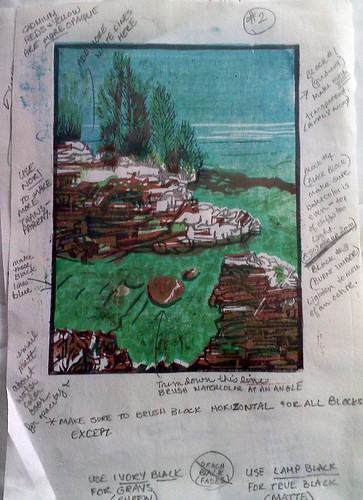This is the second proof from the project I've been working on at Spudnik Press in Chicago. Let's just say I am not happy with it right now, but that doesn't mean I won't be happy with it after making a few adjustments.
Controling the watercolor is the main problem right now. That will come with study and practise. We'll see how it looks at the end of the week.
The first block with the cyan sky gradating down to the green of the pool will have nori added to it to make it more transparent. This will make the trees pop more and the stones of the sap green block have greater contrast.
The burnt umber of the third block is too harsh and I'll be changing that to a deep ochre.
the second block using sap green will be a bit darker, maybe I'll add blue to deepen the stones in the pool.
Ivory black was used for the final block. It isn't as black as I want. Part of that has to do with the application and transfer of the watercolor, but I also learned that I should use Lamp black for a true black.
I can't wait to get home from my day job to continue working with this.
Erin K. Nolan Artist | Designer PEJ Nolan Studios Psalm 34:14 "Avoid evil and do good. Seek peace and pursue it."
6.27.2011
Second Proof: A long way to go...
6.09.2011
Spudnik Press and the Moku Hanga Adventures
I've already taken two classes. The first time, my husband came with to make sure we knew the directions and to find out what kinds of neighborhoods I would be walking around in. The train ride is nice, then it's just a few blocks of walking to reach the L's Green Line. I get off at the first stop and walk about 10 blocks.
Spudnik Press is located in an old factory building that is orange brick. I have to buzz to enter the building. The hallways are stark white: modern, crisp, and clean; but once you enter the press room and work area, it is like walking back in time. There are vintage presses, old wood floors and heavy wooden beams from the floor to the tall, open ceilings. There are small containers everywhere filled with wonderful things such as wood type, inks, glass bottles. It is small, but neatly organized. There are books and a computer to access for ideas and freshly printed artwork hangs on the walls.
The first class was an eye-opener. Having been primarily self-taught with the help of my brother who is also self-taught woodblock printmakers, I neglected to know some of the very basics like what is the best type of paper to use or how to angle the cuts just right when carving. That is exactly why I took the class and I am so very glad I worked up my courage to go. Apparently the papers I have been using are way too thin to work for moku hanga. The instructor, Matthew Messer, was surprised I could even print with kitakata and sekishu. The heavy kozo paper he showed us was excellent and will make much better prints!
The second class, I took the trip into the city by myself. I was a bit nervous because of some of the things I had seen on the street the previous week. Things like an empty bottle of vodka with underwear next to it or buildings with bars over the entrances. The neighborhood is really old. Look at the red doors in the photos above. They are tall and thin. They must have been built in the late 1800's. The building they are fit into have weathered every one of those years they look it. The textures of peeling paint and rust, the smell of the traffic, the smog from the city, hearing people yell in the distance… I know I don't belong there. I wasn't made for city life.
But then I go into another world inside Spudnik Press. For four hours I am amongst others who enjoy art and learning.
Matt brought roasted barely tea last week. It was sweet, cool, and refreshing. It reminded me of Honey Smacks cereal. In Japan it is called, mugicha (麦茶?). I'll have to make some myself or purchase some at Mitsua, the Japanese market in the Chicago suburb of Arlington Heights.
Lastly, I should mention that by the end of the class we will each have a four-color moku-hanga print. Mine will be an 8" h x 6" w Cave Point Park in Bailey's Harbor, Wisconsin - one of my favorite places to be.
Labels:
American Artist,
American Printmaker,
Chicago,
Spudnik Press
Subscribe to:
Posts (Atom)



